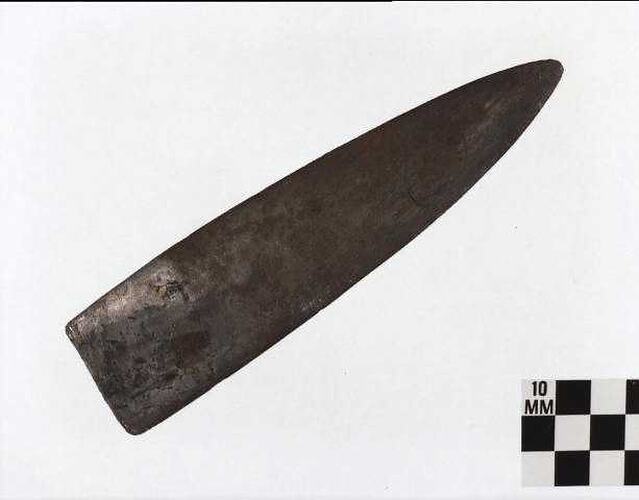Summary
Stone knives like this one were made from quartzite and the Warumungu and Tjingali people made knives for these for their own use and for exchange through the extensive trade networks across central Australia. Knives were used for butchering game such as kangaroos and emus, and used in ritualised fighting, initiation and other ceremonies. During mourning rituals, for example, some male relatives were required to use knives to cut their thighs and shoulders as a mark of respect for the deceased. Wood of the mulga tree (Acacia aneura) was used at times, and the blades fixed with resin from the leaf stalks of a species of 'Triodia', commonly known as spinifex or porcupine grass. The resin, collected by burning short pieces of spinifex on a sheet of bark, is moulded around the wood while still warm and then set hard when it cooled. To protect the sharp edges of the blade, sheaths were used, and this one here is made of paperbark. The decorative designs painted on the handles may represent the totemic ancestors of either the maker or owner of a knife. Spencer recorded in 1914 that stone knives, axes and picks were still being used among those Aboriginal groups in central Australia who had thus far had limited contact with non-Indigenous people, however they were 'yearly decreasing in numbers' as the use of European metal implements increased. This knife was collected on the Barclay-Macpherson 1911 Expedition that set out from Oodnadatta on 7 February 1911 and continued northwards ending up at Newcastle Waters then headed east to Anthony's Lagoon and Borroloola in September 1911; and then stayed in the McArthur River district until April 1912. The expedition was led by Henry Vere Barclay and the second in command was Ronald Horace Macpherson, however it is not clear who collected the artefacts on the expedition. Gerald Freer Hill was the photographer and botanist on the trip and he was also a collector who donated artefacts to the museum.
Physical Description
Knife, iron blade, handle of resin.
More Information
-
Object/Medium
Knife, hafted
-
Maker
-
Locality
-
Date Produced
-
Collector
-
Date Collected
-
Object Measurements
160 mm (Length), 40 mm (Width), 5 mm (Height)
-
Keywords
-
Collection Names
-
Type of item
-
Discipline
-
Category
-
Collecting Areas
